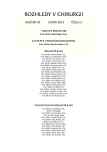Laparoscopic repair of incisional hernias – our first experience
Authors:
M. Oravský; V. Bak; T. Petrovajová; M. Rajčok; M. Schnorrer
Authors‘ workplace:
III. Chirurgická klinika LF UK Bratislava, prednosta: Doc. MUDr. M. Schnorrer, CSc.
Published in:
Rozhl. Chir., 2013, roč. 92, č. 2, s. 91-94.
Category:
Original articles
Overview
Introduction:
The authors present their first experience with the laparscopic hernioplasty of the incisional hernias appearing after laparotomy.
Material and methods:
In the period from January 2008 to June 2012, 29 patients underwent hernioplasty by the IPOM technique (Intra Peritoneal Onlay Mesh) using Teflon mesh. The patients were followed up prospectively for the mean time of 29 months. The mean age of the patients was 57 years, the average size of the hernias was 6.5 cm, and the average time of the operation was 75 minutes.
Results:
In the early postoperative period in 3 patients (11%) occurred pseudoperitonitis caused by the irritation of the peritoneum in the area of the attached mesh. In one patient (3%) severe paralytic ileus developed, and 22 patients experienced seroma in the left hernial sac. All seroma was absorbed except for one patient. In the mentioned case, seroma absorbed completely after repeated aspiration within 3 months. During the period of follow-up no patient showed any signs of recurrence.
Conclusion:
Since the first method of choice in the treament of incisional hernias after laparotomies is still unclear, laparoscopic repair seems to be a promising option. Results of laparoscopic repair are comparable with the conventional hernioplasty using mesh.
Key words:
incisional hernia – laparoscopic repair (laparoscopic hernioplasty)
Sources
1. Alder AC, Alder SC, Livingston EH, Bellows CF. Current opinions about laparoscopic incisional hernia repair: a survey of practicing surgeons. Am J Surg 2007194(5):659–62.
2. Amid PK. Laparoscopic repair of anterior abdominal wall herniation using composite mesh. Am J Surg 1996;171(5):542–3.
3. Fidler F, Kašík J. Komplikace IPOM plastiky – naše zkušenosti. Rozhl Chir 2009;(88),7:394–397.
4. Kaafarani HM. Hur K. Classification and valuation of postoperative complications in a randomized trial of open versus laparoscopic ventral herniorrhaphy. Hernia 2009;13(3):295–301
5. Schumpelick V. Incisional hernia: an unpleasant complication in surgery. Chirurg 2010;81(3):185
6. Doležel J, Vlček P, Veverková L, et al. Trendy v léčbě břišních a tříselných kýl Med Pro Praxi 2009;(6),4:209–213.
7. Burger JW, Luijendijk RW, Hop WC, Halm JA, Verdaasdonk EG, Jeekel J. Long-term follow-up randomized controlled trial of suture versus mesh repair of incisional hernia. Ann Surg 2004;240, 578–583.
8. Dumanian GA, Denham W. Comparison of repair techniques for major incisional hernias. Am J Surg 2003;(185),1:61–5,Review.
9. Langer C, Schaper A. Prognosis factors in incisional hernia surgery: 25 years of experience. Hernia 2005;(9),1:38–47.
10. Mahmoud H, Erkek A. Incisional hernia treatment with polypropylene graft: results of 10 years, Hernia 2006;(10),5:612–621.
11. Schnorrer M. Jr., Petrašovič M, Mráz P. Implantáty u recidív prietrží brušnej steny. Lekár Obzor 1998;(47),4:129–131.
12. Courtney CA, Lee AC Ventral hernia repair: a study of current practice. Hernia 2003;7(1):45–59
13. Franklin ME. Jr, Gonzalez JJ. Jr, Glass JL, Manjarrez A. Laparoscopic ventral and incisional hernia repair: an 11-year experience. Hernia 2004;(8),1:23–7.
14. Kirshtein B, Lantsberg L, Avinoach E, Bayme M, Mizrahi S. Laparoscopic repair of large incisional hernias. Surg Endosc. 2002;(16),12:1717–9.
15. Kyzer S, Alis M, Aloni Y, Charuzi I. Laparoscopic repair of postoperation ventral hernia. Early postoperation results. Surg Endosc 1999;(13),9:928–31.
16. Barbaros U, Asoglu O, Seven R, Erbil Y, Dinccag A, Deveci U, Ozarmagan S, Mercan S. The comparison of laparoscopic and open ventral hernia repairs: a prospective randomized study. Hernia 2007;(11),1:51–6.
17. Eriksen JR, Poornoroozy P, JŅrgensen LN, Jacobsen B, Friis-Andersen HU, Rosenberg J. Pain, quality of life and recovery after laparoscopic ventral hernia repair. Hernia 2009;(13),1:13–21.
18. Ballem N, Parikh R, Berber E, Siperstein A. Laparoscopic versus open ventral hernia repairs: 5 year recurrence rates. Surg Endosc 2008;(22),9:1935–40.
19. Kapischke M, Schulz T, Schipper T, Tensfeldt J, Caliebe A. Open versus laparoscopic incisional hernia repair: something different from a meta-analysis. Surg Endosc 2008;(22),10:2251–60.
20. McGreevy JM, Goodney PP, Birkmeyer CM, Finlayson SR, Laycock WS, Birkmeyer JD. A prospective study comparing the complication rates between laparoscopic and open ventral hernia repairs. Surg Endosc 2003;(17),11:1778–80.
Labels
Surgery Orthopaedics Trauma surgeryArticle was published in
Perspectives in Surgery

2013 Issue 2
- Metamizole vs. Tramadol in Postoperative Analgesia
- Metamizole at a Glance and in Practice – Effective Non-Opioid Analgesic for All Ages
- Current Insights into the Antispasmodic and Analgesic Effects of Metamizole on the Gastrointestinal Tract
Most read in this issue
- Pancreatic fistula – definition, risk factors and treatment options
- Bilateral perinatal torsion of spermatic cord – a case report and literature review
- Laparoscopic repair of incisional hernias – our first experience
- Chest wall haemorrhage as a complication of anticoagulation treatment – a case study
